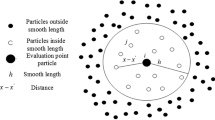Abstract
This paper is dedicated to the nanoscale machining simulation with the help of SPH method. The main goal of the research is to investigate the ductile mode machining of the brittle materials. The special scalar plasticity measure is introduced as a generic parameter of surface quality after machining. This measure can be used to describe the surface quality due to different machining modes and to analyze influence of fillet radius or cutting depth on the surface quality. As the SPH method deals with discrete particles, there is a problem of correct identification of those particles, which form the surface after machining. The special algorithm is proposed to solve this problem. Finally, the influence of the cutter fillet radius on the obtained plasticity measure is determined to be linear in considered range.
Similar content being viewed by others
References
Ruttimann N, Buhl S, Wegener K (2010) Simulation of single grain cutting using SPH method. J Mach Eng 10(3):17–29
Espinosa C, Lacome JL, Limido J, Salaun M, Mabru C, Chieragatti R (2008) Modeling high speed machining with SPH method, 10th Int. LS-DYNA Users Conf., Detroit
Chong SYu, Junming Z, Wanshan HW (2008) Numerical simulation and analysis for metal cutting processes based on FEM and SPH, system simulation and scientific computing, Asia simulation conf.—7th Int. Conf. on Sys. Simulation and Scientific Computing
Hongwei Z, Chuang L, Tao C, Ye T, Chengli S, Jianping L, Hu H (2013) Influences of sequential cuts on micro-cutting process studied by smooth particle hydrodynamic (SPH). Appl Surf Sci 284:366–371
Guo Y, Wei Y, Jin Z, Guo D, Maosen W (2013) A numerical model for optical glass cutting based on SPH method. J Adv Manuf Technol 68(5–8):1277–1283
Villumsen MF, Fauerholdt TG (2008) Simulation of metal cutting using smooth particle hydrodynamics, LS-DYNA Anwenderforum, C-III
Nam J, Kim T, Cho SW (2015) A numerical cutting model for brittle materials using smooth particle hydrodynamics. Int J Adv Manuf Technol 82(1–4):133–141
Simon S (2013) Smooth particle hydrodynamics applied to fracture. Examensarbete 30 hp.(6):1–40
Shah Q, Abid H (2012) LS-DYNA for beginners: an insight into Ls-Prepost and Ls-Dyna. Lap Lambert Academic Publishing GmbH KG, Saarbrücken
Guo X, Liu Z, Gao H, Guo D (2015) Nano–indentation study on the (001) face of KDP crystal based on SPH method. J Semicond 36(8):71–77
Guo XG, Wei YJ, Jin ZJ, Guo D, Maosen W (2013) A numerical model for optical glass cutting based on SPH method. Int J Adv Manuf Technol 68(6–8):1277–1283
Su C, Zhang Y, Hou JM (2008) Numerical simulation and analysis for metal cutting processes based on FEM and SPH. Proceedings of the 7-th Int Conf on System Simulation and Scientific Computing
Zhang C, Yuan S, Amin M, Fan H, Liu Q (2016) Development of a cutting force prediction model based on brittle fracture for C/SiC in rotary ultrasonic facing milling. Int J Adv Manuf Technol 85(1–4):573–583
Yuan S, Zhang C, Amin M, Fan H, Liu M (2015) Development of a cutting force prediction model based on brittle fracture for carbon fiber reinforced polymers for rotary ultrasonic drilling. Int J Adv Manuf Technol 81(5–8):1223–1231
Yuan S, Zhang C, Hu J (2014) Effects of cutting parameters on ductile material removal mode percentage in rotary ultrasonic face machining. Proc Inst Mech Eng B J Eng Manuf 229(9):1547–1556
Acknowledgements
The research was partially supported via the Agreement No 14.579.21.0042 25.08.2014 (id. RFMEF1579X0042) between OAO “VNIIINSRUMENT” and the Ministry of Education and Science of the Russian Federation on the subject “development of equipment and technology for nano-dimensional machining of optical materials under quasi-plastic cutting”.
Author information
Authors and Affiliations
Corresponding author
Rights and permissions
About this article
Cite this article
Gouskov, A., Nikolaev, S., Kuts, V. et al. Analysis of displacement fields of particle shaping surface during nanoscale ductile mode cutting of brittle materials. Int J Adv Manuf Technol 95, 1911–1918 (2018). https://doi.org/10.1007/s00170-017-1233-x
Received:
Accepted:
Published:
Issue Date:
DOI: https://doi.org/10.1007/s00170-017-1233-x




